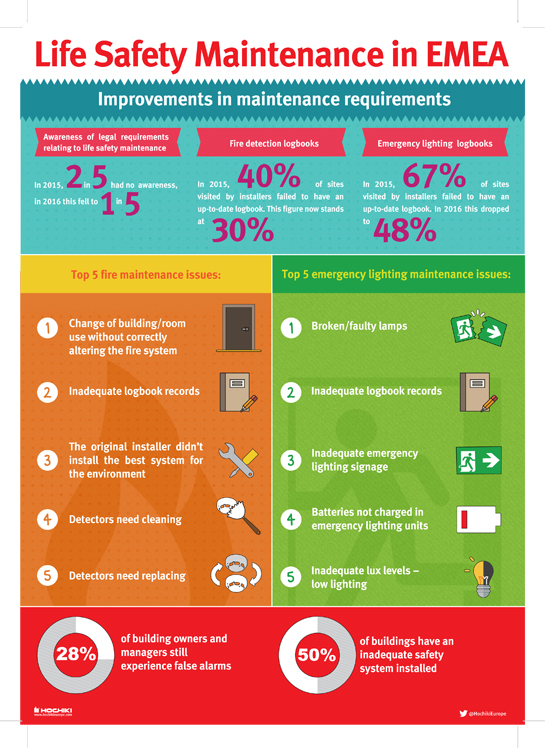A 2016 study of European Installers by a life safety solutions manufacturer found that the number of building owners and managers unaware of the legal requirements surrounding life safety system maintenance has halved. Hochiki Europe’s 2015 research found two in five, or 46 per cent, had no awareness, however that figure has dropped to one in five, or 22 per cent, in the past 12 months.
The study also showed an increase in the number of customers installers visited with up to date fire detection and emergency lighting logbooks. In 2015, two fifths of customers (40 per cent) failed to have an up to date fire detection logbook. This figure now stands at less than a third (30 per cent). The number failing to have an up to date emergency lighting logbook has dropped even further, falling from over two thirds (67 per cent) in 2015 to under half (48 per cent) in 2016.
Despite the improvements in these key areas of maintenance, the number of building owners and managers experiencing false alarms showed little change, dropping just one per cent, from 29 per cent in 2015 to 28 per cent in 2016.
Equally, the number of installers encountering buildings where customers had changed the use of their spaces, but failed to adjust their life safety systems accordingly dropped only slightly, reducing from just over half (55 per cent) to exactly half (50 per cent). This year failing to update the system correctly was the most common issue installers found when visiting a customer site.
The top five fire maintenance issues encountered by installers in 2016 were:
1.Change of building/room use without correctly altering the fire system (50 per cent)
2.Inadequate logbook records (44 per cent)
3.The original installer didn’t install the best system for the environment (40 per cent)
4.Detectors need cleaning (33 per cent)
5.Detectors need replacing (27 per cent)
The top five emergency lighting maintenance issues encountered by installers in 2016 were:
1.Broken/faulty lamps (44 per cent)
2.Inadequate logbook records (42 per cent)
3.Inadequate emergency lighting signage (39 per cent)
4.Batteries not charged in emergency lighting units (35 per cent)
5.Inadequate lux levels (25 per cent)
Tracy Kirk, General Manager of Sales and Marketing for Hochiki Europe, said: “Our annual study shows a marked improvement in both understanding and meeting maintenance requirements among building owners and managers. This suggests that, as an industry, our efforts to educate and train those responsible for maintaining life safety systems is proving successful.
“That said, we acknowledge there are still some serious gaps to continue addressing, and while these are encouraging results we cannot be complacent. Ensuring the legal requirement for keeping up to date logbooks is met, the correct system is in place and reducing false alarms are all vital to keep people safe. We will continue to provide training and information that can help our installers educate even more building managers and owners on the importance of life safety maintenance and the correct ways to carry out this.”
For more on logbook maintenance, industry CPD courses and Hochiki Europe life safety systems visit www.hochikieurope.com.










